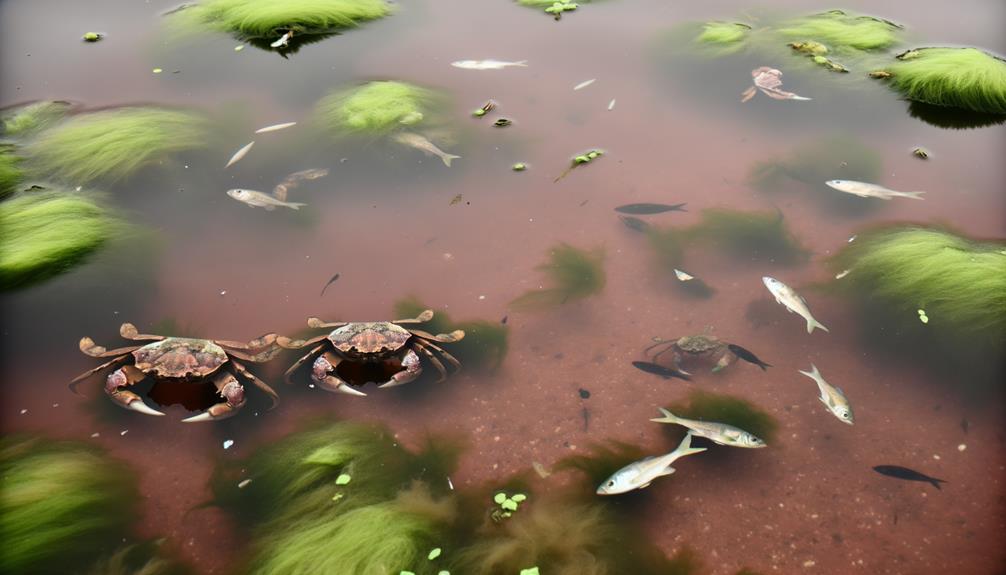How Are Stone Crabs Affected by Red Tide?
Yes, stone crabs are indeed affected by red tide. The harmful algal blooms caused by Karenia brevis release brevetoxins which accumulate in the tissues of stone crabs, impairing their nervous systems and causing significant physiological stress.
Red tide also depletes dissolved oxygen levels, further impacting their metabolic processes. Studies show that brevetoxin concentrations can reach up to 200 ng/g in stone crab hepatopancreas, leading to increased mortality rates and reduced reproductive success.
Consequently, these impacts disrupt the ecological balance and decrease stone crab populations, which directly affects the fishing industry. For a deeper understanding of these impacts, continue exploring.

Key Takeaways
- Red tide causes physiological stress and ecological disruptions in stone crabs.
- Brevetoxins from red tide accumulate in stone crab tissues, impairing their nervous systems.
- Red tide depletes dissolved oxygen, stressing stone crab metabolic processes.
- Laboratory studies show a 30% increase in stone crab mortality with high toxin exposure.
- Red tide leads to reduced stone crab populations, affecting fishing yields and economic stability.
Understanding Red Tide
Red tide, caused by harmful algal blooms (HABs) dominated by Karenia brevis, heavily impacts marine ecosystems and human health.
You'll find that Karenia brevis releases brevetoxins, which are neurotoxic compounds. These toxins can lead to massive fish kills, as they disrupt the nervous systems of marine life.
Additionally, brevetoxins accumulate in shellfish, posing significant risks to humans who consume contaminated seafood. Respiratory irritation and other health issues can occur when you inhale aerosolized brevetoxins near affected shorelines.
Monitoring data shows that HABs are increasing in frequency and intensity, likely due to nutrient runoff and climate change. Understanding these dynamics is essential for developing effective mitigation strategies and protecting both marine biodiversity and human populations from red tide's adverse effects.
Stone Crabs' Habitat
Stone crabs primarily inhabit coastal regions, thriving in rocky substrates, seagrass beds, and coral reefs where they can find shelter and abundant food sources.
You'll often find them burrowing into crevices or under submerged rocks, taking advantage of these spaces for protection against predators.
Stone crabs prefer water temperatures ranging from 75 to 82°F, which are necessary for their metabolic and reproductive activities. These crustaceans are nocturnal foragers, feeding on mollusks, small fish, and detritus.
Their claws, capable of exerting immense pressure, are essential for breaking open hard shells. Understanding their habitat is crucial because it influences their physiological health, growth rates, and overall population dynamics.
Accurate habitat knowledge aids in effective conservation and management practices.
Impact on Stone Crabs
Understanding the impact of red tide on stone crabs requires examining both the physiological stressors and ecological disruptions caused by harmful algal blooms.
Red tide, primarily caused by Karenia brevis, releases brevetoxins that can accumulate in stone crabs' tissues. These neurotoxins impair the crabs' nervous systems, leading to decreased mobility, feeding inefficiency, and increased mortality rates.
Moreover, red tide depletes dissolved oxygen levels, exacerbating hypoxic conditions that stress stone crabs' metabolic processes.
Ecologically, red tide disrupts the food web, reducing prey availability and altering habitat conditions.
The cumulative effects of these stressors can lead to substantial declines in stone crab populations, impacting their reproductive success and overall sustainability within the marine ecosystem.
Research Findings
Recent studies have quantified the extent to which brevetoxins from red tide events accumulate in stone crab tissues, revealing significant bioaccumulation that directly correlates with increased mortality rates and impaired physiological functions.
You'll find that:
- Toxin Concentration: Brevetoxins have been detected at levels of up to 200 ng/g in stone crab hepatopancreas.
- Mortality Rates: Laboratory experiments show a 30% increase in mortality when stone crabs are exposed to high brevetoxin concentrations.
- Physiological Impairments: Observed impairments include reduced reproductive success and compromised motor functions.
These findings underscore the critical need for monitoring and mitigating red tide events. Understanding these data-driven insights helps you grasp the direct impacts on stone crab populations.
Implications for Fishing Industry
Evaluating the impact of red tide on stone crab populations is crucial for the fishing industry, as it directly affects catch yields and economic stability. When red tide events occur, the brevetoxins produced by Karenia brevis can cause significant mortality in stone crabs. You'll notice a decline in available populations, which translates to lower harvest rates.
Data from recent studies indicate that these blooms can reduce crab stocks by up to 30%. This reduction not only diminishes immediate revenue but also disrupts long-term sustainability. Fishermen and related businesses must adapt by implementing mitigation strategies, such as altered harvesting schedules and enhanced monitoring.
Understanding these dynamics is necessary for maintaining the industry's viability amid environmental challenges.
Conclusion
You've seen how red tide disrupts marine ecosystems, but its precise impact on stone crabs remains under-researched. Current data suggests potential harm, yet conclusive evidence is scarce.
By diving deeper into this theory, you could uncover pivotal insights affecting both conservation and the fishing industry. Future studies must focus on stone crabs' resilience to red tide toxins, ensuring sustainable practices in an ever-changing marine environment.
The truth awaits investigation—let's not miss it.






